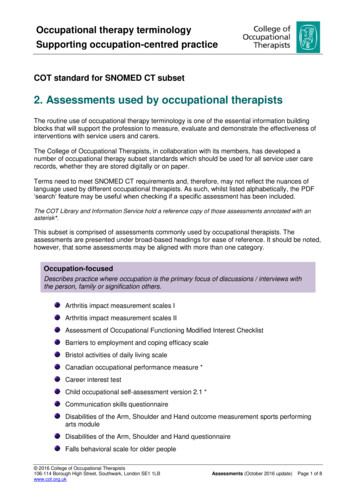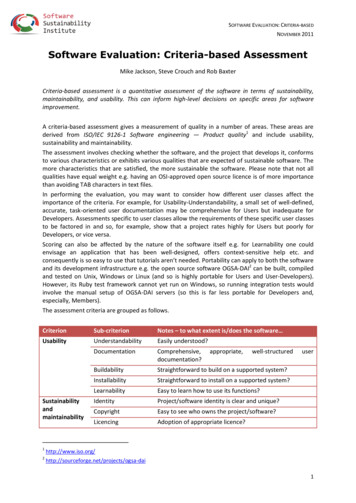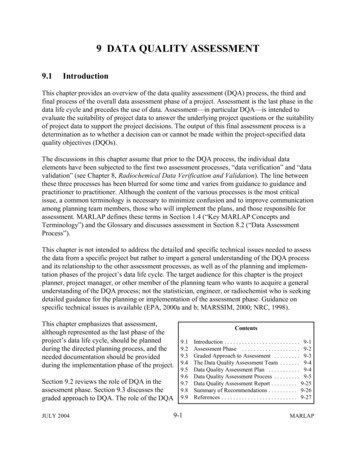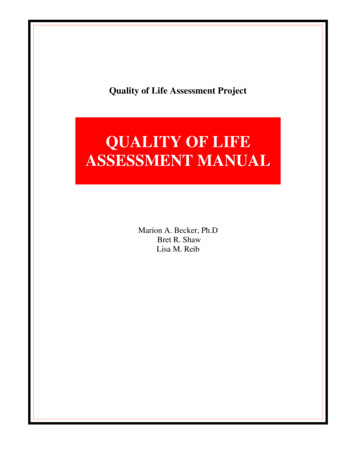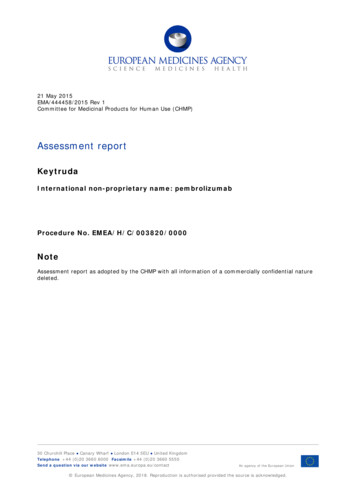
Transcription
21 May 2015EMA/444458/2015 Rev 1Committee for Medicinal Products for Human Use (CHMP)Assessment reportKeytrudaInternational non-proprietary name: pembrolizumabProcedure No. EMEA/H/C/003820/0000NoteAssessment report as adopted by the CHMP with all information of a commercially confidential naturedeleted.30 Churchill Place Canary Wharf London E14 5EU United KingdomTelephone 44 (0)20 3660 6000 Facsimile 44 (0)20 3660 5555Send a question via our website www.ema.europa.eu/contactAn agency of the European Union European Medicines Agency, 2018. Reproduction is authorised provided the source is acknowledged.
Table of contents1. Background information on the procedure . 71.1. Submission of the dossier . 71.2. Manufacturers . 81.3. Steps taken for the assessment of the product . 82. Scientific discussion . 92.1. Introduction. 92.2. Quality aspects . 112.2.1. Introduction . 112.2.2. Active Substance . 112.2.3. Finished Medicinal Product . 132.2.4. Discussion on chemical, pharmaceutical and biological aspects . 142.2.5. Conclusions on the chemical, pharmaceutical and biological aspects . 152.2.6. Recommendations for future quality development . 152.3. Non-clinical aspects . 152.3.1. Introduction . 152.3.2. Pharmacology . 152.3.3. Pharmacokinetics. 212.3.4. Toxicology . 222.3.5. Ecotoxicity/environmental risk assessment . 292.3.6. Discussion on non-clinical aspects. 292.3.7. Conclusion on the non-clinical aspects . 312.4. Clinical aspects . 312.4.1. Introduction . 312.4.2. Pharmacokinetics. 342.4.3. Pharmacodynamics . 392.4.4. Discussion on clinical pharmacology . 442.4.5. Conclusions on clinical pharmacology . 462.5. Clinical efficacy . 462.5.1. Dose response study(ies) . 462.5.2. Main study(ies) . 482.5.3. Discussion on clinical efficacy . 1032.5.4. Conclusions on the clinical efficacy . 1072.6. Clinical safety . 1082.6.1. Discussion on clinical safety . 1442.6.2. Conclusions on the clinical safety . 1462.7. Pharmacovigilance . 1472.8. Risk Management Plan . 1472.9. Product information . 1542.9.1. User consultation . 1543. Benefit-Risk Balance. 1554. Recommendations . 157Page 2/160
List of abbreviationsADAAnti-Drug AntibodiesAEAdverse EventAEOSIAdverse Events of Special InterestALPAlkaline phosphataseALTAlanine aminotrasferaseAPaTAll Patients as TreatedAPSAllred Proportion ScoreASTAspartate aminotrasferaseAUCArea under the curveCHMPCommittee for Medicinal Products for Human UserCHOChinese Hamster OvaryCIConfidence Interval(s)CYPCytochrome PCLClearanceCmaxMaximum concentrationCNSCentral Nervous SystemCRComplete ResponseCTCAECommon Toxicity Criteria for Adverse EventsCTLA4Cytotoxic T-Lymphocite antigen-4CVCoefficient of variationCYPCytochrome P450DCRDisease Control RateDLTDose Limiting ToxicityDMCData Monitoring CommitteeDTICdacarbazineEC50Half-Maximal Effective minescenceECOGEastern Cooperative Oncology GroupELISAEnzyme-Linked Immunosorbent assayEORTC- QLQEuropean Organisation for Research and Treatment of Care core Quality of LifePage 3/160
questionnaireERAEnvironmental Risk AssessmenteGFREstimated glomerular filtration rateFASFull Analysis SetFUFluorouracilFcRnFc Receptor NeonatalGCPGood clinical practiceGLPGood Laboratory PracticeHIVhuman immunodeficiency virushrHour(s)IA2Interim Analysis 2IC50Half-maximal inhibitory concentrationICHInternational Conference of HarmonisationIFNInterferonIgGImmunoglobulin leukin 2IPIipilimumabIROIntegrated radiology and oncology assessmentirRCimmune-related Response CriteriaITTintention to treatIVintravenousi.v.intravenousKDDissociation constantKMKaplan-MeierλzTerminal rate constantLDHLactate dehydrogenaseLLNlower limit normalmAbmonoclonal antibodyMAMarketing AuthorisationMAAMarketing Authorisation ApplicationPage 4/160
mgMilligrammLMillilitermk-3475pembrolizumab, KeytrudamMMillimolarMRImagnetic resonance imagingMSDMeso Scale DiscoveryN/ANot ApplicableNAbNeutralizing antibody(ies)nMNanomolarNSCLCNon-Small Cell Lung CancerORROverall Response RateOSOverall SurvivalPAESPost-authorisation efficacy studiesPKpharamcokineticsPBMCPeripheral blood (mononuclear) cellPDpharmacodynamicPDProgressive diseasePD-1Programmed Cell Death Receptor-1PD-L1Programmed Cell Death Receptor- Ligand 1PD-L2Programmed Cell Death Receptor- Ligand 2PKPharmacokineticPIPPaediatric Investigation PlanPFSProgression Free SurvivalpMPicomolarPSPerformance StatusPSURPeriodic Safety Update ReportPRPartial ResponsePRACPharmacovigilance Risk Assessment CommitteePROpatient reported outcomeQDistribution clearanceQ2Wevery 2 weeksQ3Wevery 3 weeksPage 5/160
QTcQT interval correctedRECISTResponse Evaluation Criteria In Solid TumorsRMPRisk Management PlanRRResponse RateRNARibonucleic AcidSAESerious Adverse EventSDStable diseaseSEBStaphylococcal Enterotoxin BSmPCSummary of Product Characteristicst1/2Elimination half-lifeTKToxicokineticsTmaxTime to reach maximum concentrationTNFTumor Necrosis FactorTTTetanus toxoidULNupper limit normalVcVolume of distribution central compartmentVpPeripheral volume of distributionVssDistribution Volume at steady stateWBCWhole blood cellsμgMicrogramPage 6/160
1. Background information on the procedure1.1. Submission of the dossierThe applicant MERCK SHARP & DOHME LIMITED submitted on 4 June 2014 an application for MarketingAuthorisation to the European Medicines Agency (EMA) for Keytruda, through the centralisedprocedure falling within the Article 3(1) and point 1 of Annex of Regulation (EC) No 726/2004.The applicant applied for the following indication:“KEYTRUDA is indicated for the treatment of unresectable or metastatic melanoma in adults.”The legal basis for this application refers to:Article 8.3 of Directive 2001/83/EC - complete and independent application. The applicant indicatedthat pembrolizumab was considered to be a new active substance.The application submitted is composed of administrative information, complete quality data, nonclinical and clinical data based on applicants’ own tests and studies and/or bibliographic literaturesubstituting/supporting certain test(s) or study(ies).Information on Paediatric requirementsPursuant to Article 7 of Regulation (EC) No 1901/2006, the application included an EMA DecisionP/0059/2014 on the agreement of a paediatric investigation plan (PIP) and the granting of a (productspecific) waiver.At the time of submission of the application, the PIP P/0059/2014 was not yet completed as somemeasures were deferred.Information relating to orphan market exclusivitySimilarityPursuant to Article 8 of Regulation (EC) No. 141/2000 and Article 3 of Commission Regulation (EC) No847/2000, the applicant did not submit a critical report addressing the possible similarity withauthorised orphan medicinal products because there is no authorised orphan medicinal product for acondition related to the proposed indication.Applicant’s request(s) for considerationNew active Substance statusThe applicant requested the active substance pembrolizumab contained in the above medicinal productto be considered as a new active substance in itself, as the applicant claims that it is not a constituentof a product previously authorised within the UnionScientific AdviceThe applicant received Scientific Advice from the CHMP on 13 December 2012, The Scientific AdvicePage 7/160
pertained to non-clinical and clinical aspects of the dossier.Licensing statusKeytruda has been given a Marketing Authorisation in the USA on 4 September 2014.1.2. ManufacturersManufacturer of the biological active substanceMedImmune, LLC Frederick Manufacturing Center (FMC)633/636/660 Research Court FrederickMD 21703-8619, USAManufacturer responsible for batch releaseSchering-Plough Labo NVIndustriepark 30Heist-op-den-BergB-2220, Belgium1.3. Steps taken for the assessment of the productThe Rapporteur and Co-Rapporteur appointed by the CHMP were:Rapporteur: Daniela MelchiorriCo-Rapporteur: Jan Mueller-BerghausCHMP Peer reviewer: Pieter de Graeff The application was received by the EMA on 4 June 2014. The procedure started on 25 June 2014. The Rapporteur's first Assessment Report was circulated to all CHMP members on 12 September2014. The Co-Rapporteur's first Assessment Report was circulated to all CHMP members on 12September 2014. The PRAC RMP Advice and assessment overview were adopted by PRAC on 9 October 2014.During the meeting on 20-23 October 2014, the CHMP agreed on the consolidated List ofQuestions to be sent to the applicant. The final consolidated List of Questions was sent to theapplicant on 24 October 2014. The applicant submitted the responses to the CHMP consolidated List of Questions on 20 February2015. The Rapporteurs circulated the Joint Assessment Report on the applicant’s responses to the Listof Questions to all CHMP members on 3 April 2015. The PRAC RMP Advice and assessment overview were adopted by PRAC on 10 April 2015. During the CHMP meeting on 20-23 April 2015, the CHMP agreed on a list of outstanding issuesto be addressed in writing by the applicant.Page 8/160
The applicant submitted the responses to the CHMP List of Outstanding Issues on 27 April 2015. The Rapporteurs circulated the Joint Assessment Report on the applicant’s responses to the CHMPList of Outstanding Issues on 5 May 2015. PRAC RMP Advice and assessment overview was adopted on 4 May 2015. During the meeting on 21 May 2015, the CHMP, in the light of the overall data submitted and thescientific discussion within the Committee, issued a positive opinion for granting a MarketingAuthorisation to Keytruda.2. Scientific discussion2.1. IntroductionMelanoma is the most aggressive form of skin cancer. Melanoma is the sixth and seventh mostcommon malignancy in men and women, respectively.1 The median age at diagnosis is 59 years. Theincidence of melanoma varies between different European countries but the estimated incidence wasabout 39.6 cases /100.000 men and 42.5 cases /100.000 women in 2012. In Europe in 2012, themortality rate was approximately 8.8 cases/100.000 in males and 6.9 cases/100.000 in females. 1 Theoutcome of melanoma depends on the stage at presentation 2. Approximately 85% of patients withmelanoma present with localised disease, 10% with regional disease and 5% with distant metastaticdisease. The 5-year survival rates in patients who present with localised disease and primary tumours1.0mm or less in thickness are very good, with more than 90% of patients surviving. The 5-yearsurvival rates decrease as the tumour spreads: for tumours of more than 1.0mm in thickness, survivalrates range from 50% to 90%, with regional node involvement survival rates are around 50%, forwithin stage III (regional metastatic melanoma) 5-year survival rates range between 20-70%,depending on primary nodal involvement. The long term survival for distant metastatic melanoma, the5-year survival is less than 10%.Current treatments for metastatic melanoma include systemic therapy, surgery and radiotherapy.Spontaneous regression of melanoma has been reported with an incidence of less than 1%. Completeresection of isolated metastases to one anatomic site (lung, gastrointestinal tract, bone or brain) mayoccasionally achieve long term survival. Systemic treatment may consist of chemotherapy, and/orimmunotherapy. Palliative radiotherapy is indicated for symptomatic relief of metastases to brain,bones and viscera.Chemotherapy with dacarbazine (DTIC) may achieve objective response rates of about 20%, of whichless than 5% is complete remission. Higher response rates have been seen using combinationchemotherapy, however no increase in over-all survival has been demonstrated with combinationregimens when compared to dacarbazine alone. Immunotherapeutic agents used for metastaticmelanoma are interferon-alfa (IFNα) and interleukine-2 (IL-2). Recurrent melanoma is resistant tomost standard systemic therapy and no standardized effective second line treatment is established.1Ferlay J., Steliarova-Foucher E., Lortet-Tieulent J., et al. Cancer incidence and mortality patterns in Europe: Estimatesfor 40 countries in 2012. Eur J Cancer; 49, 1374– 1403, 2013Balch CM., Gershenwald JE., Soong SJ., et al. Final version of 2009 AJCC melanoma staging and classification. J ClinOncol; 27(36):6199-206, 20092Page 9/160
In EU Countries, dacarbazine was used for many years as standard first line treatment of patients withmetastatic melanoma 3. Clinical trials with dacarbazine have shown low response rates ranging from11% -25%, low rate of complete responses and of short duration (3 to 6 months). The median survivaltime ranged from 4.5 to 6 months 4,5,6. Ipilimumab (Yervoy), a human monoclonal antibody againstCTLA-4, was approved in the EU in 2011 for melanoma patients who have received prior therapy. Theapproval of ipilimumab was based on the results of a phase III study performed in previously treatedmelanoma patients was associated with a statistically significant improvement in overall survival (OS)compared with the gp100 vaccine (10.1 versus 6.4 months; HR: 0.66; p 0.003). In recent times, theserine-threonine kinase BRAF was discovered mutated in many cancers 7. BRAF mutations have beenfound in approximately 50% of melanoma, 30-70% of thyroid carcinomas, 30% of ovarian carcinomaand 10% of colorectal carcinoma. Oncogenic mutations in BRAF result in constitutive activation of theRAF-MEK-ERK pathway which in turn stimulates cell growth, proliferation and cell survival in theabsence of typical growth factors 8. For patients with tumours harbouring the BRAFV600 mutation,kinase inhibitors vemurafenib (Zelborarf) and dabrafenib (Tafinlar) were approved in the EU in 2012and 2013, respectively, and target directly the mutated protein BRAFV600. Vemurafenib (Zelboraf), asfirst line treatment was approved based on the results of the pivotal phase III study (BRIM3) and wasassociated with a median progression-free survival (PFS) 6.9 vs 1.6 months, respectively (HR 0.38,95%CI: 0.32-0.46, p 0.0001) and median OS 13.6 vs 9.7 months (HR: 0.70, 95%CI: 0.57-0.87,p 0.0001) compared with DTIC. Dabrafenib (Tafinlar), as first line therapy was approved based on theresults of the pivotal trial BREAK-3 that showed a median PFS of 6.9 vs 2.7 months for the dabrafeniband DTIC group respectively, (HR: 0.37; 95% CI: 0.24, 0.58; p-value 0.0001) and OS (HR 0.76,95%CI: 0.48, 1.21); a 12 month OS rate of 70 % and 63 % for dabrafenib and DTIC treatments,respectively). Trametinib (Mekinist) was approved in 2014 to target the mitogen-activated extracellularsignal regulated kinase 1 (MEK 1 and MEK 2) proteins to dampen the signalling pathway that promotesproliferation and survival in BRAFV600 mutated melanoma. Mekinist as first line of treatment wasapproved based on the results of a phase III study that showed a median PFS 4.8 vs 1.5 months,respectively (HR 0.45; 95%CI:0.33, 0.63; p-value 0.0001) and median OS of 15.6 vs 11.3 months(HR 0.78; 95%CI 0.57, 1.06) for trametinib and dacarbazine respectively.The co-inhibitory receptor programmed cell death – 1 (PD-1) is a key regulator of T cell activity thatbelongs to the same immunoglobulin superfamily which includes the co-stimulatory receptor CD28 andthe co-inhibitory receptor CTLA-4. 9, Pembrolizumab is a humanised monoclonal anti-programmed celldeath-1 (PD-1) antibody (IgG4/kappa isotype with a stabilising sequence alteration in the Fc region)produced in Chinese hamster ovary cells by recombinant DNA technology. It binds to the PD-1 receptorand blocks its interaction with PD-1 ligand (PD-L1) and PD-1 ligand 2 (PD-L2). The PD-1 receptor is anegative regulator of T cell activity that has been shown to be involved in the control of T cell immuneresponses. Engagement of PD-1 with the ligands PD-L1 and PD-L2, which are expressed in antigenpresenting cells and may be expressed by tumours or other cells in the tumour microenvironment,results in inhibition of T cell proliferation and cytokine secretion. Pembrolizumab potentiates T cellresponses, including anti-tumour responses, through blockade of PD-1 binding to PD-L1 and PD-L2ligands.3Serrone L, Zeuli M, Sega FM, et al. Dacarbazine- based chemotherapy for metastatic melanoma: Thirty year experienceoverview. J Exp Clin Cancer Res; 19: 21-34, 20004Luce JK, Thurman WG, Isaacs BL, et al. Clinical trials with the antitumor agent . Cancer Chemother Rep; 54:119-124, 19705Hill GJ, Moss SE, Golomb FM, et al. DTIC and combination therapy for melanoma. Cancer; 47:2556-2562, 19816Falkson G, Van der Merwe AM, Falkson HC: Clinical experience with 5-(3,3–bis(2-chloroethyl)- 1-triazeno)-imidazole-4carboxamide (NSC 82196) in the treatment of metastatic malignant melanoma. Cancer Chemother Rep; 56:671-677, 19727Davies H, et al. Mutations of the BARF gene in human cancer. Nature; 417:949-954, 20028Garnett MJ and Marais R. Guilty as charged: B-RAF is a human oncogene. Cancer Cell; 6:313-319, 20049Nurieva RI, Liu X., Dong C., Molecular mechanism of T-cell tolerance J Immunol; 241: 133–44, 2011Page 10/160
The applicant applied for the following indication:“KEYTRUDA is indicated for the treatment of unresectable or metastatic melanoma in adults.”The final approved indication was:“KEYTRUDA as monotherapy is indicated for the treatment of advanced (unresectable or metastatic)melanoma in adults.”The recommended dose of KEYTRUDA is 2 mg/kg administered intravenously over 30 minutes every 3weeks. Patients should be treated with KEYTRUDA until disease progression or unacceptable toxicity.Atypical responses (i.e., an initial transient increase in tumour size or small new lesions within the firstfew months followed by tumour shrinkage) have been observed. It is recommended to continuetreatment for clinically stable patients with initial evidence of disease progression until diseaseprogression is confirmed.Guidelines for withholding or discontinuation of KEYTRUDA are described in Table 1 of the SmPC.KEYTRUDA should be permanently discontinued: For Grade 4 toxicity except for endocrinopathies that are controlled with replacement hormones If corticosteroid dosing cannot be reduced to 10 mg prednisone or equivalent per day within 12weeks If a treatment-related toxicity does not resolve to Grade 0-1 within 12 weeks after last dose ofKEYTRUDA If any event occurs a second time at Grade 3 severity2.2. Quality aspects2.2.1. IntroductionThe active substance of Keytruda (50 mg powder for concentrate for solution for IV infusion) ispembrolizumab (MK-3475), which is a humanised monoclonal antibody that binds to human PD-1 andblocks the interaction between PD-1 receptor and its ligands. MK-3475 is an IgG4 monoclonal antibodywith Class-II mechanism of action (binding to cell-bound antigen not involving Fc effector function).2.2.2. Active SubstanceIt is an IgG4/kappa isotype with a stabilizing SER228PRO sequence alteration in the Fc region; it couldbe demonstrated that the S228P mutation introduced into MK-3475 in the IgG4 hinge region preventsthe formation of half molecules. Induction of half molecules, if not in that way engineered, is typical forIgG4 antibodies. The molecular characteristics were determined by a combination of techniquesincluding mass spectrometry, peptide mapping, and N-glycan profiling.The antibody is heterogeneously glycosylated at Asn297 within the Fc domain of each heavy chain,yielding a molecular weight of approximately 149 kDa for intact MK-3475. The dominant glycoform isthe fucosylated agalacto diantennary glycan form (G0F).The observed molecular weight of the most abundant form of the intact antibody is 148.9 kDa, whilethe most abundant forms of the heavy and light chains are 50.7 kDa and 23.7 kDa, respectively.Manufacturing processMK-3475 is a humanised monoclonal antibody that is expressed as a secreted product from asuspension Chinese Hamster Ovary (CHO) cell line. A fully characterised Master Cell Bank (MCB) aswell as a Working Cell Bank (WCB) was established. Cells from the WCB are expanded in shake flasks,disposable rocker bags, and a seed bioreactor to generate the inoculum for a production bioreactor toproduce the antibody product. The downstream processing includes three chromatography steps, twoPage 11/160
orthogonal viral clearance steps, ultrafiltration/diafiltration, and a final 0.2 µm filtration step. All rawmaterials used in upstream/downstream manufacturing processes are animal component free.Upstream and downstream processing is considered as state of the art for production of monoclonalantibodies.Definitions of key terms were provided by the Applicant as follows: Critical Quality Attribute (CQA): A critical quality attribute (CQA) is a physical, chemical, biologicalor microbiological property or characteristic that should be within an appropriate limit, range, ordistribution to ensure the desired product quality (ICH Q8). Critical Process Parameter (CPP): A process parameter whose variability has an impact on criticalquality attribute and therefore should be monitored or controlled to ensure the process producesthe desired quality (ICH Q8). Key Process Attribute (KPA): Process and/or product attributes that are primary measure(s) of theconsistency of performance for each step. Key Operating Parameter (KOP): Parameter whose variability has an impact on a KPA and thereforeshould be monitored or controlled to ensure the desired consistency of performance.Process developmentThere have been no major process changes other than scale and site changes between non-clinical andclinical manufacturing: non-clinical manufacturing was performed at the pilot plant facility using theMSB. Initial clinical manufacturing was performed at the clinical manufacturing facility. For initialclinical supplies, manufacture started from the MCB. Meanwhile, a working cell bank (WCB) has beenqualified and introduced into the process. To enable facility fit at larger scale and also to increaseproductivity and robustness of downstream steps to ensure an adequate supply of MK-3475, the activesubstance manufacturing process has been transferred from the clinical site to a commercialmanufacturing facility with greater capacity (MedImmune (FMC); Frederick Manufacturing Center,Frederick, MD). In addition to a change in scale of the active substance manufacture, other changeswere made to further enhance the robustness of the commercial active substance manufacturingprocess.Process validation, also referred to as Process Performance Qualification (PPQ), demonstrated thatfor all four PPQ batches, the predefined acceptance criteria for the upstream CQAs (of the unprocessedbulk) and for the downstream CQAs (active substance) were consistently met.The active substance is already finally formulated. Active substance from FMC is stored at -40 5 Cand shipped at -35 C to the finished product manufacturing location.Site changes were supported following ICH guideline Q5E by process and analytical comparabilitystudies (comparative release testing and comparative extended site by site characterisation studies)including comparative long term stability assessments. Sufficient comparability for active substancefrom the clinical manufacturing site and active substance from FMC was demonstrated. Minordifferences were sufficiently characterised (and understood). These root cause investigations(characterisations) were considered adequate and the outcome (i.e. no effect on safety and/or efficacymay be expected) seems plausible.CharacterisationThe primary, secondary, tertiary, and quaternary structures of MK-3475 were evaluated using a seriesof biochemical, biophysical and functional characterisation techniques. The single characterisationmethods are considered scientifically justified, sufficient sensitive and state of the art and thereforesuitable for characterisation of the active substance.Product-related species of MK-3475 active substance were adequately separated by methods thatexploit differences in molecular size, charge, and hydrophobicity.Process-related impurities were adequately determined and include CHO host cell proteins (HCP),CHO host cell DNA and Protein A.ControlThe active substance Quality Control for batch release includes identity, potency (competitive bindingELISA), purity and impurities and several other general tests.Reference StandardPage 12/160
As defined by ICH Q6B, an in-house reference material, manufactured at WAG facility, has beenestablished for MK-3475.StabilityBased on the presented 18 months real time real condition long-term stability data for the threeprimary batches the claimed shelf life of 18 months at -40ºC is considered justified.2.2.3. Finished Medicinal ProductDescription and compositionFinished product, powder for solution for infusion, single-use 50 mg/vial is reconstituted with sterilewater for injection and further diluted with normal saline (0.9% sodium chloride injection) or 5%dextrose (5% dextrose injection; also referred to as 5% glucose) prior to IV administration.Formulation development and optimisation studies have shown the pH of optimum product stability tobe pH 5.2-5.8. Further low moisture content of the finished product lyophilisate ensures productstability. MK-3475 finished product does not contain any overages.Process developmentInitially, clinical materials have been manufactured at the clinical manufacturing facility. Increasingdemand for finished product based on promising clinical data required an increase in capacity.Therefore, a second site, Schering-Plough (Brinny) in Innishannon, Ireland (further referred to asBrinny) was added as a finished product manufacturing site to supply the clinical trials.Site changes were supported following ICH guideline Q5E by process and analytical comparabilitystudies (comparative release testing and comparative site by site extended characterisation studies)including comparative long term stability assessments.ManufactureFor the manufacture of MK-3475 finished product, FMC active substance is delivered as frozen finalformulated bulk (FFB) solution containing the exact formulation of the final finished product. Thefinished product manufacturing process consists of thawing, pooling, bioburden reduction filtration,sterile filtration, filling, lyophilisation, capping, and visual inspection.The manufacturing process for finished product and its controls (in-process control (IPC) and criticalprocess parameters (CPP) ranges) are adequately presented. The defined critical process parametersare justified. The proven acceptable ranges and the defined normal operating ranges are consideredacceptable for the critical process parameters.The defined IPCs an
The long term survival for distant metastatic melanoma, the 5-year survival is less than 10%. Current treatments for metastatic melanoma include systemic therapy, surgery and radiotherapy. Spont





